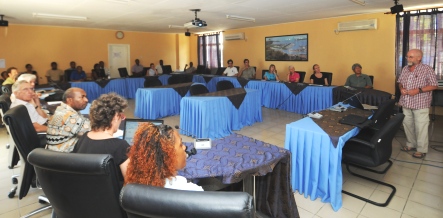Study cites risk of invasive birds’ spread to Aldabra |12 April 2012

The red-whiskered bulbul and the Madagascar fody are two species of birds which are not native to Assumption island – being introduced there in the mid-1970s from Mauritius – and their complete removal from the eco-system has been seen as necessary.
This is especially since Aldabra – only 27 kilometres away – has only native species living there found nowhere else in the world, which could be threatened by any foreign birds establishing populations there.
After almost six months of work British professor Chris Feare was on Monday afternoon giving a presentation on the eradication of the bulbuls and fodies carried out on Assumption.
He told stakeholders in the Seychelles Fishing Authority’s training room that the eradication project is an initiative of the Seychelles Island Foundation (SIF) and funded by the European Union.
Professor Feare said after five and a half months, they had caught and killed around 1,309 bulbuls, which is 31% of the estimated 4,300. As for the fodies, 932 were killed, which is an estimated 60% of the total population.
“I emphasise on the ‘estimated’ because they were not accurate counts, but was the best we could do but we must also stress the importance of repeating the activity each year for a number of years,” he said.
Another worry of Professor Feare is the fact that a parasitic worm has been found in the bodies of both species of birds, and he says they have not yet determined if the parasite is one they brought in when introduced to Assumption or whether the birds picked it up on the island.
“We do not know how dangerous it might be if it gets to Aldabra, but it gives us all the more reasons to work even harder on eradicating these two birds before they get themselves – and that infection – to Aldabra,” he said.
Several methods have been used to trap the birds, such as shooting, setting traps. But, mist nets, however, proved the most effective way of capturing the birds, where a very fine net is erected on poles, which the birds cannot see – especially at dawn and dusk – and they fly into and are trapped.
Professor Feare said they are considering the use of poisons, but will only do so if they get an environmentally-friendly substance, which is as humane as possible in its effect on the birds and safe for people in the area.
“So far we have not been able to identify such a chemical, but the seriousness of the presence of those two birds on Assumption means that we’re probably going to go down that road in the future,” he said.




